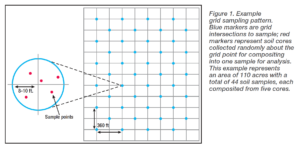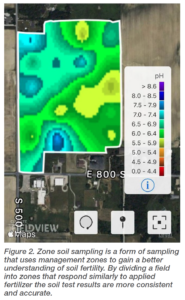Q. What is soil testing?
Soil testing is one of the many tools farmers use to improve plant growth, yield potential and to apply the most economical rate of plant nutrients. Soil sampling must be conducted properly to obtain quality soil test results. Each sample should be representative of the entire field or specified sampling unit. Soil testing in combination with plant tissue testing and field yield data help growers make appropriate nutrient management decisions throughout the growing season.
Q. What are two common methods for soil sampling?
The two primary methods are grid sampling and zone sampling.
Grid sampling. If there is little information about the variability of nutrient levels across the field, grid sampling should be used, particularly when the field history is not known. Additionally, grid sampling should be used if topography is uniform but different soil types occur and management strategies in the past have been varied or manure has been applied. Proper grid sampling makes it possible to identify variation within a field and is important to determine future management zones for fertilizer applications. Grid sampling can create valuable insights for precision applications of plant nutrients. In addition, results can be imported into FieldView™ to inform scripting of soil zones for fertility and seeding rates.
Grid sampling involves taking samples at regular intervals across the field. Grid size is selected to provide the desired data resolution. A 2.5-acre grid size is commonly used 360 x 360 feet; however, choosing a grid size that matches up to fertilizer application equipment widths is recommended. The goal of grid sampling is to determine the best estimate of each soil test value near the center of the area that is being sampled. One method is to lay out a grid of the final grid size over the field and take a series of 5 to 10 cores around each grid point (where the lines intersect). Individual cores should be collected in a radius of 8-10 feet of the grid point, to a depth of 8 inches (Figure 1).

Zone Sampling. If the field has uniform areas that can be managed the same way, sample the uniform areas as a single area and use the average of the soil samples to manage each zone. The success of the zone sampling method is only as good as the information that is used to delineate the zones. Tools such as soils maps, yield maps, topographic maps, management history and field experience can be used (Figure 2). Zones can be a better choice than a grid sampling program if the farmer has a long history of working with the field. The goal of the zone method is to determine the best estimate and use that estimate for the entire zone. Subsamples within the zone should be taken randomly, perhaps using a M or W pattern with 10-15 cores per sample zone up to 25 acres. Geo-referenced sample points can give a better opportunity to compare estimates over time by returning to near the same point during the next sampling period.
Q. What does a soil test consist of?
Soil testing should include an analysis for macronutrients and secondary nutrients [nitrogen (N), phosphorus (P), potassium (K), sulfur (S), calcium (Ca), and magnesium (Mg)], micronutrients [copper (Cu), iron (Fe), manganese (Mn), zinc (Zn), boron (B), chloride (Cl), nickel (Ni), and molybdenum (Mo)], soil pH, buffer pH, organic matter, and cation exchange capacity. Due to variability in soils, lab analysis methods, and reporting, regional guidelines may exist. A local agronomist can provide information specific to your area.
Q. How are soil tests interpreted?
The results from a soil test will list the type of test conducted, the concentration of specific parameters (such as P), an interpretation value (low, optimum, and high), and recommendations for amendment management or nutrient application. When reviewing the lab results, it is crucial to know what extraction method was used. Labs may report results in parts per million (ppm) or lb/acre.

To convert ppm to lb/acre, multiply ppm by
2 (lb/acre = ppm x 2).
To convert lb/acre to ppm, divide lb/acre by
2 (ppm = lb/acre ÷ 2).
Q. Which steps determine the value of a good soil sample?
Timing, sampling depth, and tillage system are important to consider while taking soil samples. The value of a soil sample depends on three main steps:
1) Collecting consistent soil samples from year to year
2) Proper analysis of lab results
3) Following through on lab recommendations.
Q. How deep should you sample?
Samples must be taken at the proper depth during the same time frame every year, ideally after harvest and before the ground freezes. Sample depth can vary by test but is usually 0 – 6 inches or 6 – 12 inches. In no-till or reduced-tillage systems, nutrients can become stratified. In this case, a separate analysis is needed on the upper 5 cm (2 inches) of the soil cores. If dry soil conditions prohibit taking soil cores to the appropriate depth, wait to sample until soil conditions improve.
Q. When and how frequently should soil testing be conducted?
Fall is the best time for soil testing, and it is recommended every 4 years or less. If there are concerns about your soil fertility, or you experienced very low crop yields, then soil testing should be done annually to help identify the problem.
